Our earth is truly a majestic place that will simply blow your mind. Each of us love to may think of taking vacations, going to wonderful places to relax such as natural wonders or paradise on earth.
But in fact some of the most stunning places, things and events that nature has to offer are probably the things you may never heard of, and they are all magnificent you wont believe they are real – that’s what this top 10 list is all about.
Here is the top 10 amazing natural phenomenon in the world.
10 – Frozen Methane Bubbles
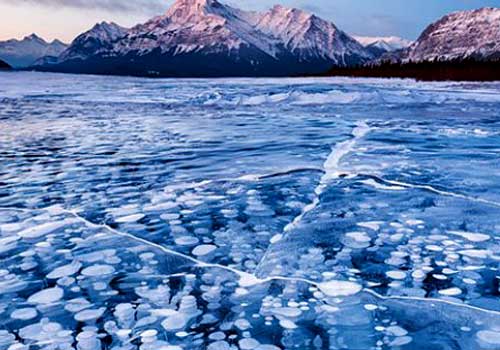
These frozen bubbles under Alberta’s Lake Abraham might look like winter jewels, but you wouldn’t want to be too close to one if it popped: the bubbles are actually frozen pockets of methane, a highly flammable gas. Most of the time, methane escaping from the surface of water is relatively harmless—but if you happen to be lighting a match at the time one of these bubbles explodes, watch out.
Methane bubbles form in bodies of water when dead organic matter (leaves and animals) falls into the water and sinks to the bottom, to the delight of bacteria waiting below. The bacterium munches on the matter and poops out methane, which turns to white floating blobs when it comes into contact with frozen water. Methane is formed in thousands of lakes around the arctic, but decreasing permafrost means more and more of this methane is being released into the atmosphere, a worrying trend for climate scientists who note that methane is a more potent greenhouse gas than carbon dioxide.
(Source)
9 – Salt Flat Mirror
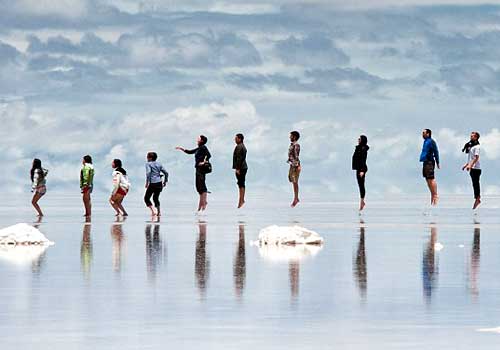
This natural mirror is created when a thin film of water gathers on a vast plain of salt deposits. So magnificent is the dream-like sight that the salt pans in the Salar de Uyuni in Bolivia have been dubbed ‘heaven on earth’.
Salar de Uyuni is the world’s largest salt flat at 10,582 square kilometers (4,086 sq mi). It is located in the Potosí and Oruro departments in southwest Bolivia, near the crest of the Andes and is at an elevation of 3,656 meters (11,995 ft) above mean sea level.
The Salar was formed as a result of transformations between several prehistoric lakes. It is covered by a few meters of salt crust, which has an extraordinary flatness with the average altitude variations within one meter over the entire area of the Salar.
The crust serves as a source of salt and covers a pool of brine, which is exceptionally rich in lithium. It contains 50 to 70% of the world’s lithium reserves, which is in the process of being extracted. The large area, clear skies, and the exceptional flatness of the surface make the Salar an ideal object for calibrating the altimeters of Earth observation satellites.
8 – Light Pillars

A light pillar is a visual phenomenon created by the reflection of light from ice crystals with near horizontal parallel planar surfaces. The light can come from the Sun (usually at or low to the horizon) in which case the phenomenon is called a sun pillar or solar pillar. It can also come from the Moon or from terrestrial sources such as streetlights.
7 – Bioluminescent Waves
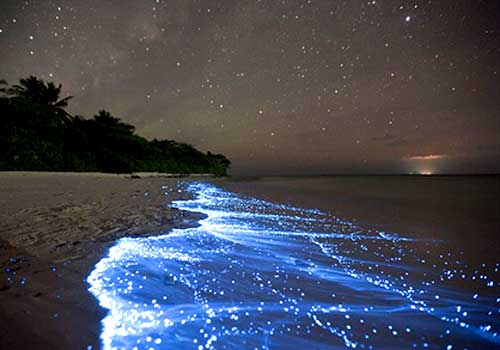
Commonly called as ‘Sea of Stars’, Pinpricks of light on the shore seem to mirror stars above in an undated picture taken on Vaadhoo Island in the Maldives.
The biological light, or bioluminescence, in the waves is the product of marine microbes called phytoplankton—and now scientists think they know how some of these life-forms create their brilliant blue glow.
Various species of phytoplankton are known to bioluminesce, and their lights can be seen in oceans all around the world, said marine biologist and bioluminescence expert Woodland Hastings of Harvard University.
“I’ve been across the Atlantic and Pacific, and I’ve never seen a spot that wasn’t bioluminescent or a night that [bioluminescence] couldn’t be seen,” Hastings said.
The most common type of marine bioluminescence is generated by phytoplankton known as dinoflagellates.
A recent study co-authored by Hastings has for the first time identified a special channel in the dinoflagellate cell membrane that responds to electrical signals—offering a potential mechanism for how the algae create their unique illumination.
(Source)
6 – Stone Lake
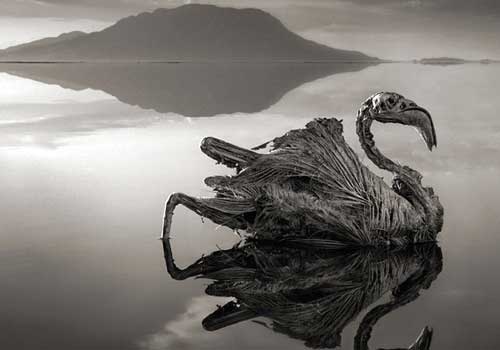
Lake Natron in Tanzania is one of the most serene lakes in Africa, but it’s also the source of some of the most phantasmagorical photographs ever captured — images that look as though living animals had instantly turned to stone.
The alkaline water in Lake Natron has a pH as high as 10.5 and is so caustic it can burn the skin and eyes of animals that aren’t adapted to it. The water’s alkalinity comes from the sodium carbonate and other minerals that flow into the lake from the surrounding hills. And deposits of sodium carbonate — which was once used in Egyptian mummification — also acts as a fantastic type of preservative for those animals unlucky enough to die in the waters of Lake Natron.
Despite some media reports, the animal didn’t simply turn to stone and die after coming into contact with the lake’s water. In fact, Lake Natron’s alkaline waters support a thriving ecosystem of salt marshes, freshwater wetlands, flamingos and other wetland birds, tilapia and the algae on which large flocks of flamingos feed. Now, photographer Nick Brandt has captured haunting images of the lake and its dead in a book titled “Across the Ravaged Land” (Abrams Books, 2013).
(Source)
5 – Morning Glory Clouds

The Morning Glory cloud is a rare meteorological phenomenon occasionally observed in different locations around the world. The southern part of Northern Australia’s Gulf of Carpentaria is the only known location where it can be predicted and observed on a more or less regular basis. The settlement of Burketown attracts glider pilot’s intent on riding this phenomenon.
Morning Glory clouds can most often be observed in Burketown in September to mid—November, when the chance to see it early in the morning is approximately 40%. A Morning Glory cloud is a roll cloud that can be up to 1,000 kilometres (620 mi) long, 1 to 2 kilometres (0.62 to 1.2 mi) high, often only 100 to 200 metres (330 to 660 ft) above the ground and can move at speeds up to 60 kilometres (37 mi) per hour. Sometimes there is only one cloud, sometimes there are up to eight consecutive roll clouds. The Morning Glory is often accompanied by sudden wind squalls, intense low-level wind shear, a rapid increase in the vertical displacement of air parcels, and a sharp pressure jump at the surface.
In the front of the cloud, there is strong vertical motion that transports air up through the cloud and creates the rolling appearance, while the air in the middle and rear of the cloud becomes turbulent and sinks. The cloud can also be described as a solitary wave or a soliton, which is a wave that has a single crest and moves without changing speed or shape.
(Source)
4 – Fire Rainbow
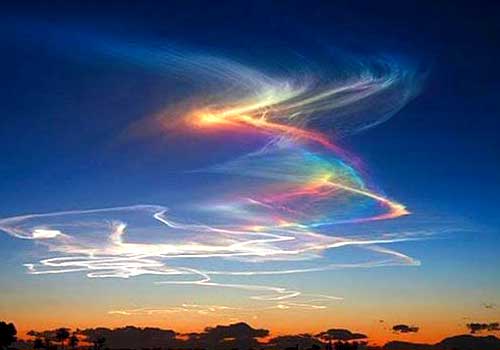
Fire rainbows, or more officially (and more boringly) known as “circumhorizonal arcs” are caused by ice crystals in the thin, distant clouds being at just the correct angle to refract the sunlight into the colors of the prism.
These “fire rainbows” (so nicknamed by appearance, not by having anything to do with fire or rainbows) are fairly rare sights in the mid-latitudes, because they can only occur when the sun is 58 degrees or higher above the horizon. For the Pacific Northwest, that pretty much relegates any sightings to around 6 weeks either side of the summer solstice.
(Source)
3 – Supercells
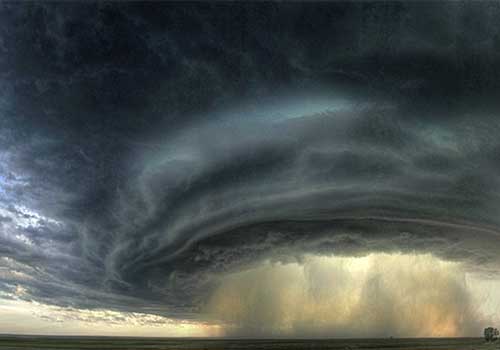
A supercell is a thunderstorm that is characterized by the presence of a mesocyclone: a deep, persistently rotating updraft. For this reason, these storms are sometimes referred to as rotating thunderstorms. Of the four classifications of thunderstorms (supercell, squall line, multi-cell, and single-cell), supercells are the overall least common and have the potential to be the most severe. Supercells are often isolated from other thunderstorms, and can dominate the local weather up to 32 kilometres (20 mi) away.
Supercells are often put into three classification types: Classic, Low-precipitation (LP) and High-precipitation (HP). LP supercells are usually found in climates that are more arid, such as the high plains of the United States, and HP supercells are most often found in moist climates. Supercells can occur anywhere in the world under the right pre-existing weather conditions, but they are most common in the Great Plains of the United States in an area known as Tornado Alley and in the plains of Argentina, Uruguay and southern Brazil.
2 – Volcanic Lightning
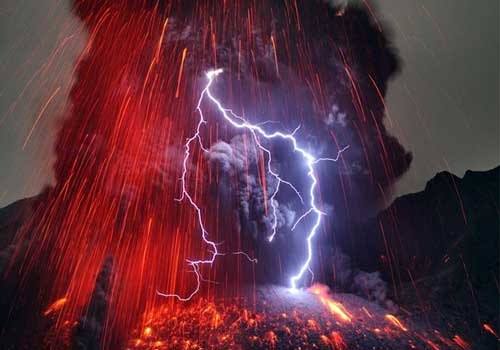
Few phenomena can compete with the raw beauty and devastating power of a raging thunderstorm, save for a particularly violent volcanic eruption. But when these two forces of nature collide, the resulting spectacle can be so sublime as to defy reason.
Smaller eruptions tend to be accompanied by more diminutive storms, which can be difficult to spot through thick clouds of ash. What’s more, lightning activity is highest during the beginning stages of an eruption, making it all the more challenging to capture on film. Photographing a big volcanic event at any stage is hard enough as it is; if you’re not nearby when it happens, says Rietze, “you will always arrive too late.”
It turns out the same things that make volcanic lightning hard to photograph also make it difficult to study. The first organized attempt at scientific observation was made during Iceland’s Surtsey eruption in 1963. The investigation was later recounted in a May 1965 issue of Science:
“Measurements of atmospheric electricity and visual and photographic observations lead us to believe that the electrical activity is caused by the ejection from the volcano into the atmosphere of material carrying a large positive charge.”
Translation? Volcanic lightning, the researchers hypothesize, is the result of charge-separation. As positively charged ejecta makes its way skyward, regions of opposite but separated electrical charges take shape. A lightning bolt is nature’s way of balancing the charge distribution. The same thing is thought to happen in regular-old thunderstorms. But this much is obvious, right?
(Source)
1 – Blue Lava
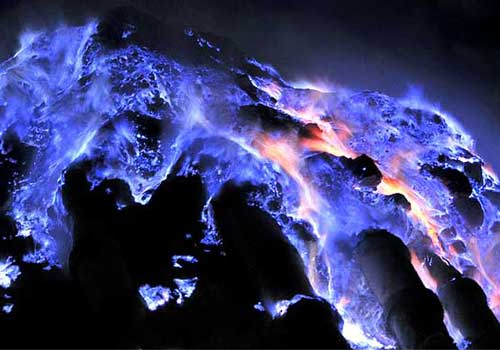
Little of the web coverage, though, has enlightened readers on the scientific principles at work. This blue glow, unusual for a volcano, isn’t the lava itself, as unfortunately can be read on many websites. It is due to the combustion of sulfuric gases in contact with air at temperatures above 360°C.
In other words, the lava—molten rock that emerges from the Earth at ultra-high temperatures—isn’t colored significantly differently than the lava at other volcanoes, which all differ slightly based on their mineral composition but appear a bright red or orange color in their molten state. But at Kawah Ijen, extremely high quantities of sulfuric gases emerge at high pressures and temperatures (sometimes in excess of 600°C) along with the lava.
Exposed to the oxygen present in air and sparked by lava, the sulfur burns readily, and its flames are bright blue. There’s so much sulfur, Grunewald says, that at times it flows down the rock face as it burns, making it seem as though blue lava is spilling down the mountainside. But because only the flames are blue, rather than the lava itself, the effect is only visible at night—during daytime, the volcano looks like roughly any other.
(Source)
